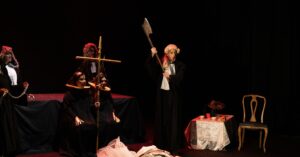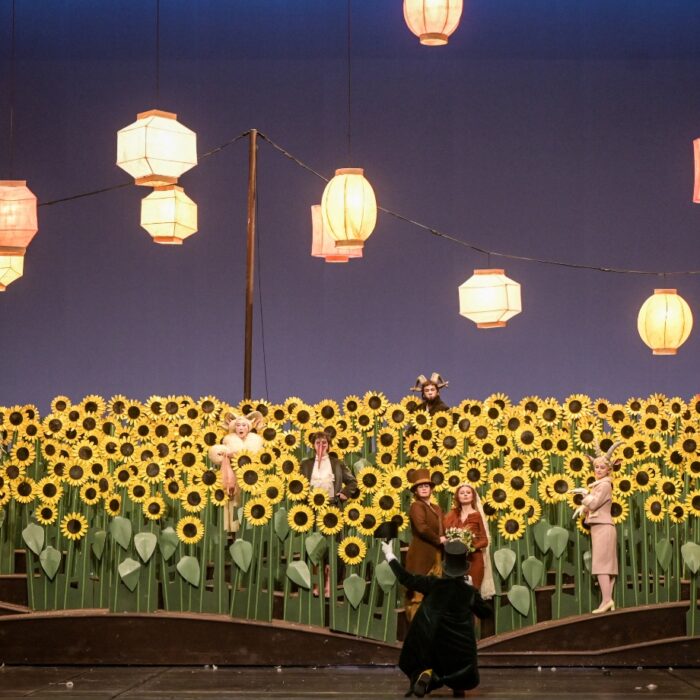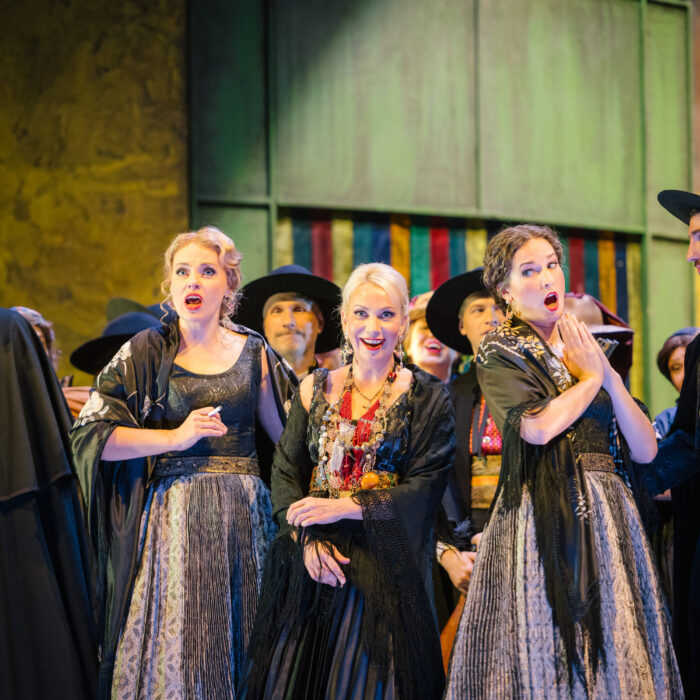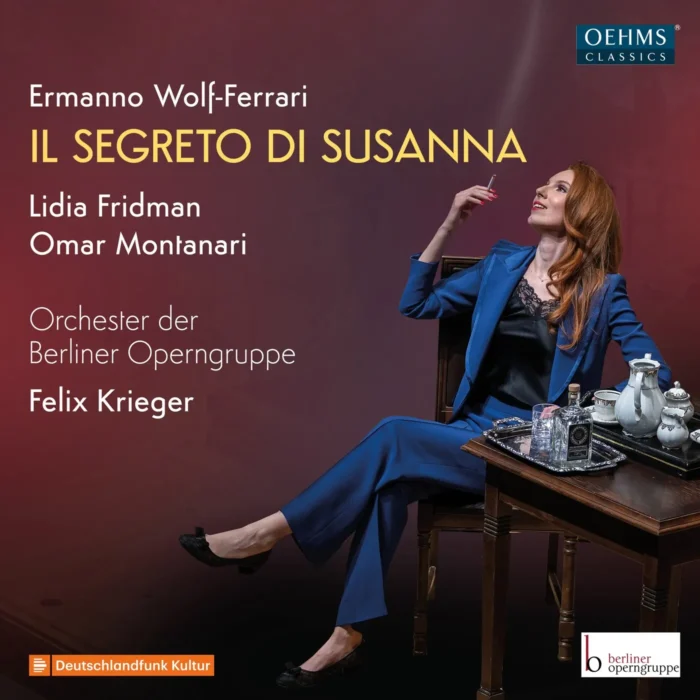
Teatro Lirico Sperimentale di Spoleto 2024 Review: Procedura Penale & La Smorfia
Two Neglected Works Successfully Staged Overseen by Bongiovanni and Angius
By Alan Neilson(Photo: Niccol Perini)
Each year the Teatro Lirico Sperimentale of Spoleto runs prestigious advanced training courses for young opera singers. Over the years, many great Italian artists have walked through its doors, including Franco Corelli, Giuseppe Di Stefano, Renato Bruson, Anna Moffo, Leo Nucci and Daniela Barcellona. The courses extend over a two-year period, running from April to October, where they provide masterclasses with well-known artists, coaching in the singers’ preferred repertoire, as well as practical experience with the singers providing the cast for fully staged performances during the theatre’s opera season.
This year is the company’s 78th season, for which, among other events, the young singers performed two neglected opera buffa from 1959: Luciano Chailly’s “Procedura Penale” to a libretto by Dino Buzzati, and Bruno Bettinelli’s “La Smorfia” to a libretto by Riccardo Bacchelli. The two works, which were originally written for the Villa Olmo International Festival in Como, were designed to be performed as companion pieces.
On the surface, at least, there seems to be little to unite the two pieces apart from they are both classified as opera buffa. However, the director for this production, Giorgio Bongiovanni, sees a fundamental similarity in that they both open up ‘cracks’ from which the dreams and nightmares of the unconscious burst through into real life with disrupting effects, before sealing over and allowing daily life to return to normal.
Procedura Penale: A Multilayered Comedy
The vacuous life of the Countess Mauritia Delormes, whose days revolve around chatting and gossiping with friends about the latest tittle-tattle while enjoying cups of tea and cake, is thrown into a chaotic nightmare when she is accused of murder. It is, of course, a completely absurd claim, but everyone present immediately wants resolution: is she guilty or not? The drawing room descends into a state of absurdity as the guests put her on trial, in which the characters adopt their positions and play out their courtroom roles with conviction. Passions run wild and tempers flair while the countess, at her wits end, is plunged into a state of torment and is found guilty. The ‘crack’ then heals, and they return to their tea and cakes. The countess, the victim of this surreal nightmare, has not learned a thing and continues with her superficial existence.
Bongiovanni’s presentation was very effective in bringing his interpretation to the stage. He not only quickly established clearly defined characters, but also successfully created the distinctive changing moods that took hold of them as they shifted from idle chitchat of the drawing room to the heated court confrontations and back again. The sets, designed by Andrea Stanisci, were carefully used to reinforce the impression of the comfortable, carefree lifestyle of the characters with a neatly constructed drawing room that changed radically into a menacing courtroom bathed in blood red light, in which even an axe was brought onto the stage as they considered executing her. Clelia De Angelis’s sensitive costume designs supported the staging with early to mid-20th century bourgeois clothing, which was quickly changed to the black robes and wigs for the courtroom scene.
All the singers acquitted themselves well, making strong, positive impressions.
Soprano Aloisia De Nardis produced an excellent performance as Contessa Mauritia Delormes, capturing her emotional rigidity and underlying anxiety from the very beginning, which she then allowed to manifest as the pressures from her ‘friends’ grew. She possesses a secure, bright, high-lying voice, with which she is able to move rapidly up and down the scale with a high degree of agility and precision, which she used successfully to develop her character.
Soprano Eleonora Benetti as Donna Titti Stefanetti gave a pleasing vocal performance in which she embraced the role’s high tessitura; her nimble, agile voice enabled her to dance with carefree, casual ease across the line.
Baritone Marco Guarini was a severe, hard Giandomenico, which could not hide the warm, attractive timbre of his voice. He showed off his his talent with an expressively convincing performance.
Of the five female singers, mezzo-soprano Emma Alessi Innocenti, playing the role of Paola Isoscele, was the only one who was not a soprano, and was thus responsible for adding variety to the vocal texture of the piece, which she did splendidly in a colorful and expressively nuanced performance, full of detail and expressivity. She also had the opportunity to perform what was the opera’s most immediately attractive aria, which allowed her to show off her well-crafted phrasing along with the beauty of her voice.
Tenor Nicola Di Filippo, cast as Dr. Polcevera, acted as the judge in the courtroom scene, for which he assumed a terrifying presence as he stood on the table berating and abusing the countess, displaying skill in his ability to coat and inflect the voice with malice. It was also a clearly articulated performance.
A pair of female twins, who sat on the fringes of the drama, acting and singing in unison, added a further bizarre feature to the drama, particularly during the courtroom scene in which they sat in front of the judge’s table with their heads inserted into the scales of justice. They were played by sopranos Chiara Guerra and Viktoriia Balan, both of whom gave solid performances.
The Ensemble Calamani del Teatro Lirico Sperimentale, under the baton of Marco Angius, successfully captured the dramatic nature of the score, which was always kept closely aligned to the onstage drama; tensions, balance between the singers and the pit, pace and dynamics were all sensitively managed. The soundscape contained a pleasing array of textures and rhythmic variety, and although there were very few immediately accessible melodies, the score as a whole was engaging and pleasing on the ear. He was always attentive to the needs of the young cast.
It is certainly an opera that is funny in parts, but it is much more than that. Bongiovanni’s staging, in which he opens up the chasm that exists between daily life and the unconscious, was perceptive and convincing, and whether intentionally or otherwise, he also drew attention to other aspects of human existence, not least to our readiness to uncritically accept roles, not just on a behavioral level but also emotionally, with little regard to its effects on others.
La Smorfia: A Comedy in the Traditional Mould
The second opera was set more clearly within the tradition of opera buffa. Not only is it deliberately constructed with comedy as its main focus, with the usual misunderstandings and love interests, but it also contains the stock figures one normally finds in the genre, particularly with the role of the chemist, Astronio Tridapali, who plays the typical buffo bass-baritone role of the irascible, demanding older man who the younger characters plot against.
Tridapali is a chemist and seemingly a man of science, yet he is convinced that the winning numbers for the lottery can be divined by interpreting a dream using the mysterious tome, ‘La Smorfia.’ Obviously, the numbers selected are not the winners, which leads to recriminations and scorn from his fellow investors. By allowing the world of dreams from the unconscious and occult knowledge to clash with daily reality and his world of science, Tridapali has opened up a ‘crack’ causing widespread disruption before it closes to restore calm.
For its staging, Bongiovanni decided on a safe, traditional reading that played up the comedy and allowed the sentimental love interest in the form of Adone, Tridapali’s assistant, and Vanda, his niece, to bloom. Stanisci’s single set was exactly as described in the libretto, down to the old medicine jars on the shelves and the pharmacy’s logo on the counter. Costumes were again of the early to mid-20th century, in which Tridapali was done up to look like a mad scientist.
The staging had a manic quality about it; the characters were always on the move, often exaggerating their reactions and movements. Bongiovanni, however, occasionally toned it down, especially during the love scenes involving Vanda and Adone, preventing it from becoming one-paced and dramatically dull.
The cast was completely different from “Procedura Penale” with the exception of Nicola Di Filippo, who played the part of Luigi del Fante, one of the men, along with Franco Bizzi, parted by tenor Federico Vita, who had put money on Tridapali’s winning numbers. Both gave energetic, busy portrayals supported by solid vocal performances, which captured their initial enthusiasm and then rage when the numbers failed to win.
It was bass-baritone Davide Piva in the role of the chemist Tridapali, who stood out with his larger-than-life mad scientist presentation and who possessed an uncanny similarity to Albert Einstein. He hammed up the part at every turn, successfully creating the typical buffo character; he was bad-tempered, authoritarian, argumentative and bullying, whilst for the most part coming across as ridiculous. His singing was equally strong; his phrasing was sensitively developed to bring out both his feelings and his underlying absurdity. The voice was resonant, secure and full of character, and he was able to use it with a sensitive delicacy when required.
His assistant, the put upon young Adone Vigorelli, was essayed by tenor Paolo Mascari, who portrayed him as a good-natured, slightly naïve young man who always managed to find himself on the wrong side of Tridapali. He possesses an attractive voice with a pleasing lyrical quality, which he displayed most notably in the scenes with Tridapali’s niece, Vanda.
Together with soprano Kristyna Kustkovà, who played the role of Vanda, they made a convincing couple, a typical pair of opera buffa lovers rebelling against an authority figure who is determined to keep them apart. There was a good sense of balance between them, although she was more assertive at crucial moments.
Bass Ferruccio Finetti was parted as Lucio Baiesi, Tridapali’s good friend, and another of his fellow investors in the lottery. He has a clear, articulate and expressive voice that he used to good effect to voice his opinions when the numbers failed to win.
The Ensemble Calamani del Teatro Lirico Sperimentale produced another fine performance under the direction of Angius, in which it established a pleasing momentum that captured the energy of the onstage chaotic excitement with its fast-changing short melodic passages, along with its calmer, reflective sections. Again, Angius gave careful attention to the needs of the singers.
“La Smorfia” is a more straightforward drama than “Procedura Penale” and had little to offer beyond the comedy, but it was entertaining and kept the audience amused. Bongiovanni’s idea of a ‘crack’ opening up to allow the unconscious to burst through to disrupt reality, although valid, had less impact on the presentation than in Chailly’s companion piece, in which it really did transform how the work could be perceived.
The performance took place in the Teatro Caio Melisso, which dates back to the mid 17th century, although it has undergone a number of renovations and transformation since then. What it does retain, however, is its intimacy. It seats only 350 people, which was ideal for the two chamber operas.
Overall, “Procedura Penale” and “La Smorfia” proved to be an excellent choice for a double bill. They are both entertaining as pieces of drama and the music has quality. They were also effective vehicles for developing the skills and experiences of the young singers.



